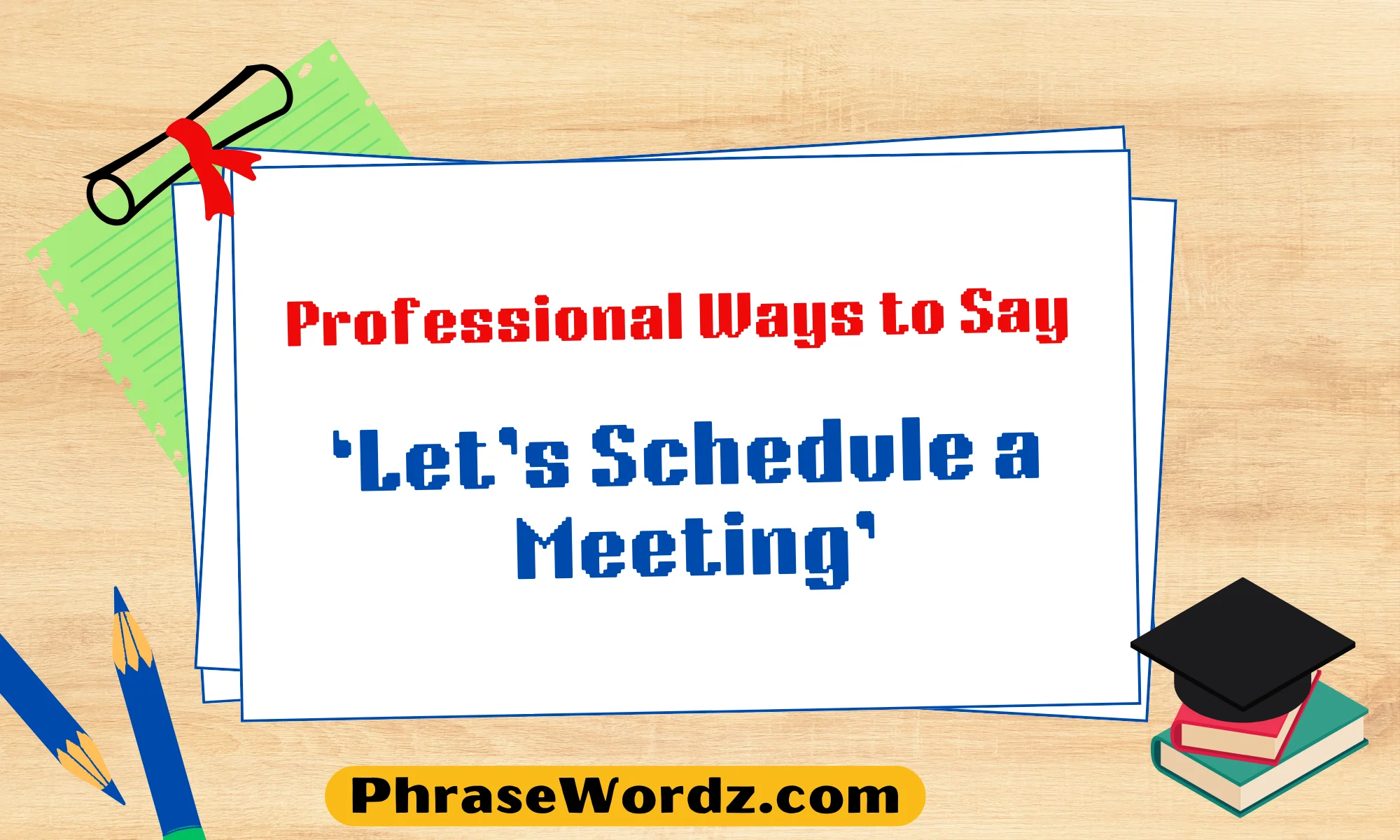Scheduling meetings is a regular part of professional life, but how you phrase the request can vary greatly depending on the setting, the relationship with the recipient, and the level of urgency.
Looking for professional ways to say “Let’s Schedule a Meeting”? Discover refined alternatives that enhance clarity and maintain professionalism in your communication.
Whether you’re drafting an email, a formal letter, or a quick message, these phrases ensure you sound polished and considerate of others’ time.
Below, you’ll find professional ways to say “Let’s schedule a meeting,” along with real-world scenario examples for each one. These suggestions can help ensure your communication remains polite, clear, and effective.
List Of Ways to Say ‘Let’s Schedule a Meeting’
- Can We Arrange a Time to Meet?
- Let’s Set Up a Meeting
- Would You Be Available for a Meeting?
- Can We Block Some Time for a Meeting?
- Would You Be Open to Scheduling a Meeting?
- Let’s Plan a Time to Meet
- Can We Pencil in a Meeting?
- Shall We Set a Time to Discuss?
- Can We Coordinate Our Schedules for a Meeting?
- I’d Like to Schedule a Time to Meet
- Can We Lock in a Time for a Meeting?
- Let’s Find a Time to Connect
- I Suggest We Arrange a Meeting
- Shall We Lock in a Time for Our Meeting?
- Can We Fix a Time for a Meeting?
- Let’s Coordinate a Meeting Time
- I’d Like to Propose a Meeting
- Can We Schedule a Time to Talk?
1. Can We Arrange a Time to Meet?
This polite and straightforward request works well in both formal and casual situations.
(Example)
Hi Mia,
I hope you’re doing well. Can we arrange a time to meet sometime this week to go over the project updates? I’m available on Thursday and Friday afternoons. Let me know what works best for you.
Best regards,
Hannah
2. Let’s Set Up a Meeting
A direct yet professional way to suggest scheduling a meeting.
(Example)
Hi Mia,
Let’s set up a meeting to discuss the upcoming deadlines for the project. I’m free on Tuesday or Wednesday afternoon. Please let me know your availability.
Kind regards,
Hannah
3. Would You Be Available for a Meeting?
A polite inquiry into the other person’s availability, making it clear that their schedule is a priority.
(Example)
Hi Mia,
Would you be available for a meeting sometime next week? I’d love to go over the quarterly report and ensure we’re aligned on the next steps. Please suggest a time that works for you.
Best,
Hannah
4. Can We Block Some Time for a Meeting?
Using “block some time” adds a sense of formality and structure, suitable for more professional settings.
(Example)
Dear Mia,
Could we block some time for a meeting early next week to discuss the client’s feedback? I’m available Monday or Tuesday after 2 PM. Let me know if either of these works for you.
Best regards,
Hannah
5. Would You Be Open to Scheduling a Meeting?
This phrasing is both polite and formal, ideal for more respectful communications.
(Example)
Hi Mia,
Would you be open to scheduling a meeting later this week to discuss our new strategy? I’d appreciate your insights before we move forward. Please let me know your availability.
Best,
Hannah
6. Let’s Plan a Time to Meet
A slightly less formal way to suggest scheduling a meeting, is suitable for colleagues you regularly work with.
(Example)
Hey Mia,
Let’s plan a time to meet next week to finalize our upcoming presentation. I’m available any time after 1 PM on Wednesday. Let me know what suits your schedule.
Thanks,
Hannah
7. Can We Pencil in a Meeting?
This phrasing implies a flexible scheduling option, as “pencil in” suggests the time can be adjusted if needed.
(Example)
Hi Mia,
Can we pencil in a meeting for Thursday morning to review the latest updates from the client? If that time doesn’t work, I can adjust my schedule. Let me know what’s best for you.
Best,
Hannah
8. Shall We Set a Time to Discuss?
A softer approach is often used when the meeting is more of a discussion or collaboration.
(Example)
Hi Mia,
Shall we set a time to discuss the new marketing strategy next week? I’m free Monday or Tuesday morning. Let me know if those times work for you.
Kind regards,
Hannah
9. Can We Coordinate Our Schedules for a Meeting?
This option emphasizes finding a mutually agreeable time for both parties.
(Example)
Hi Mia,
Can we coordinate our schedules for a meeting sometime next week to go over the final draft? I’m available on Wednesday and Thursday after lunch. Please let me know when you’re free.
Best,
Hannah
10. I’d Like to Schedule a Time to Meet
A more formal and direct way to request a meeting, suitable for situations where you need to convey importance.
(Example)
Dear Mia,
I’d like to schedule a time to meet and discuss the upcoming changes in our department. Please let me know your availability early next week.
Best regards,
Hannah
11. Can We Lock in a Time for a Meeting?
Using “lock in” implies finalizing a specific time for the meeting, ensuring there are no changes.
(Example)
Hi Mia,
Can we lock in a time for a meeting to go over the budget for next quarter? I’m available on Thursday morning. Let me know if that works for you.
Thanks,
Hannah
12. Let’s Find a Time to Connect
This is a more casual, approachable way to ask for a meeting, suitable for colleagues or people you know well.
(Example)
Hi Mia,
I hope you’re doing well. Let’s find a time to connect next week to discuss the event planning. I’m open on Monday and Tuesday afternoons. Does either work for you?
Best,
Hannah
13. I Suggest We Arrange a Meeting
A professional and confident way to propose a meeting, ideal when you need to take charge of the situation.
(Example)
Dear Mia,
I suggest we arrange a meeting to discuss the progress of the project. I’m available next Wednesday or Thursday morning. Please let me know your availability.
Kind regards,
Hannah
14. Shall We Lock in a Time for Our Meeting?
This phrasing is suitable when both parties have expressed interest in meeting, but a time hasn’t been confirmed yet.
(Example)
Hi Mia,
We’ve talked about going over the final report—shall we lock in a time for our meeting next week? I’m available on Tuesday and Thursday afternoons.
Looking forward to hearing from you,
Hannah
15. Can We Fix a Time for a Meeting?
This is a polite, professional way to propose a firm, set time for a meeting.
(Example)
Hi Mia,
Can we fix a time for a meeting to discuss the feedback from our latest client survey? I’m available Friday morning. Let me know if that works for you.
Best,
Hannah
16. Let’s Coordinate a Meeting Time
This phrase emphasizes collaboration and mutual convenience in setting up a meeting.
(Example)
Hi Mia,
Let’s coordinate a meeting time next week to go over the annual performance review. I’m free on Tuesday or Wednesday in the afternoon. Does that work for you?
Best regards,
Hannah
17. I’d Like to Propose a Meeting
A formal way to suggest a meeting, this phrase implies you’re about to propose specific dates or times.
(Example)
Dear Mia,
I’d like to propose a meeting to go over the contract details before the signing. How does Thursday at 10 AM sound? If that time isn’t convenient, I’m happy to adjust.
Kind regards,
Hannah
18. Can We Schedule a Time to Talk?
This is a casual way of suggesting a meeting, particularly when it will be more conversational.
(Example)
Hi Mia,
Can we schedule a time to talk next week? I’d love to get your thoughts on the new software rollout. I’m available on Tuesday morning or Thursday afternoon. Let me know what works for you.
Best,
Hannah
Conclusion
There are countless ways to suggest scheduling a meeting and choosing the right one depends on your audience, the context, and the level of formality. From the polite “Would you be available for a meeting?” to the more direct “Let’s finalize a time for the meeting,” these professional phrases ensure you have the right tone for any situation. Tailor your communication to maintain professionalism while also accommodating the recipient’s preferences and availability.











